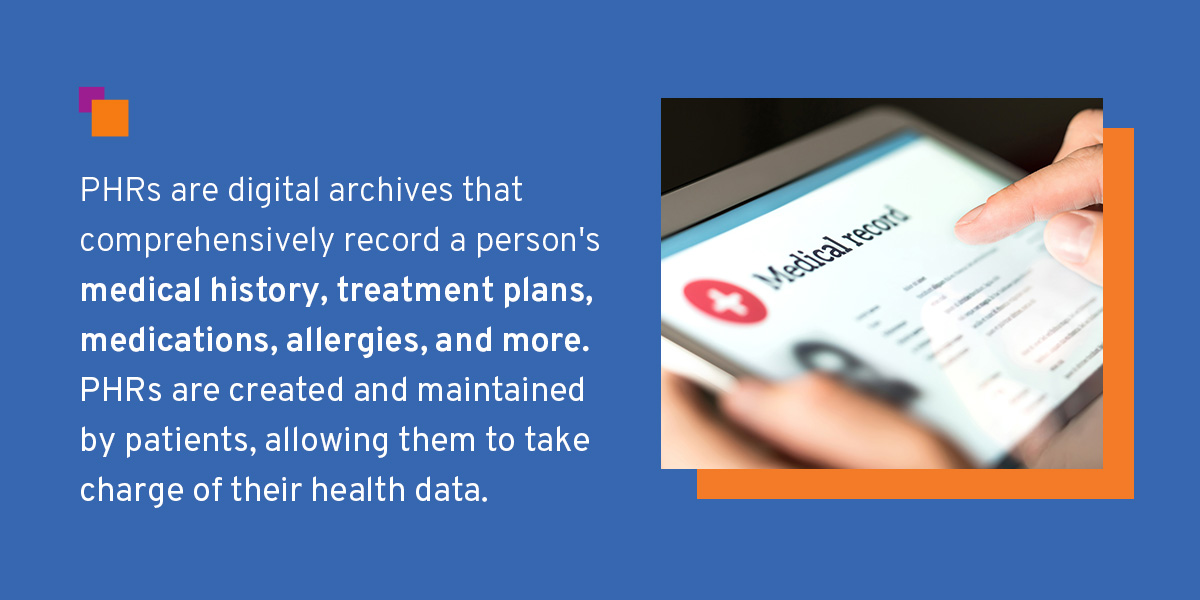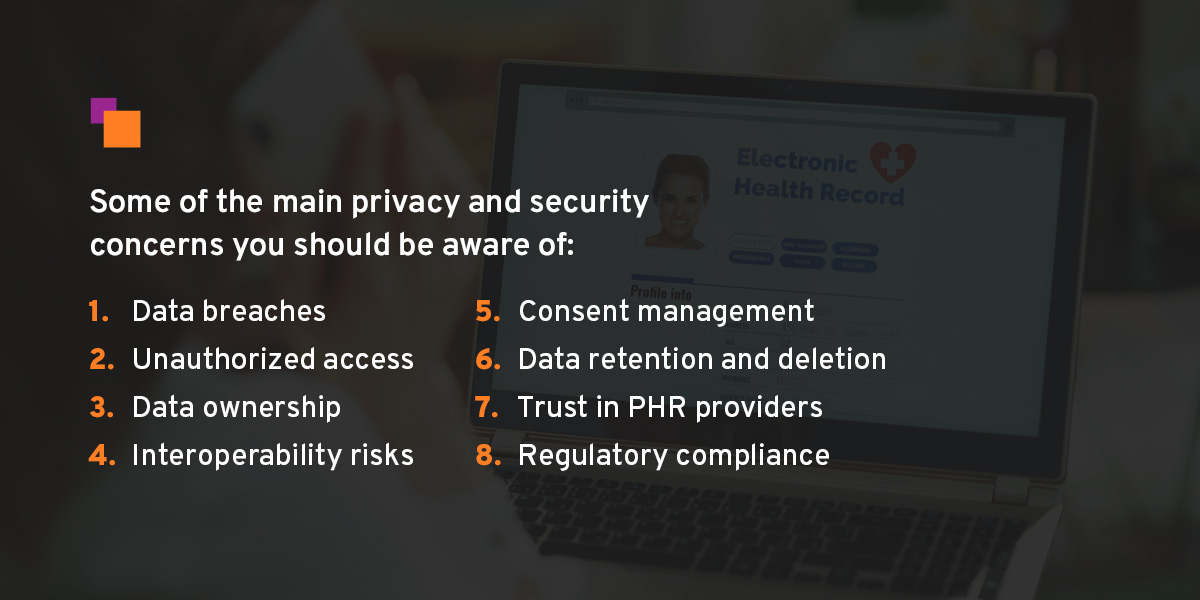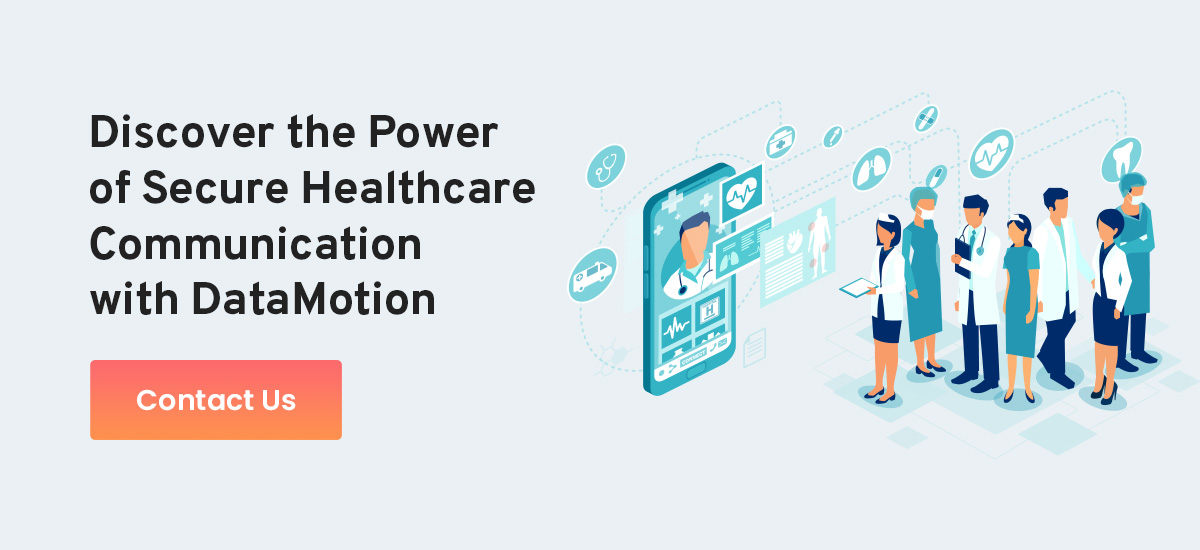As the United States healthcare industry continues its journey to digital/electronic health records that can be easily exchanged as patients move between care settings, practical questions abound:
- Who owns your electronic health records?
- Where are your health records?
- How can they be consolidated?
- Where should they be stored?
- Who should have access?
- How can they be shared?
Legally, each individual ‘owns’ their personal health data and records, but very few of us have actual ‘control’ over them, at least from a storage, curation and management standpoint. An individual’s ‘longitudinal record’ — a comprehensive collection of well-care records, like annual physicals and labs, and episodic care records, like diagnosis and treatment for illness or injury, is not typically in one place.
The benefits of personal health records include easier health information access and a secure place to store all of one’s healthcare data.

What Is a Personal Health Record (PHR)?
PHRs are essential to modern healthcare, empowering individuals to manage their own health information and play a more active role in their healthcare. At their core, PHRs are digital archives that comprehensively record a person’s medical history, treatment plans, medications, allergies, and more. Unlike electronic health records (EHRs), which are under the control of healthcare providers, PHRs are created and maintained by patients, allowing them to take charge of their health data.
As the healthcare landscape embraces digital transformation, PHRs have become a valuable tool for promoting patient-centered care. However, they also raise important questions about data security, interoperability, and privacy.
Types of Personal Health Records
PHRs come in two main types, catering to different needs and preferences:
- Tethered PHRs: These are often linked or “tethered” to a specific healthcare institution or provider’s EHR system. Patients can access their medical information from that particular provider or network. Tethered PHRs ensure data accuracy and direct integration with a healthcare system, but they may limit access to a patient’s complete health history.
- Standalone PHRs: Standalone PHRs are independent of any healthcare institution or EHR system. Patients create and manage their records, adding information like medical history, prescriptions, and test results themselves. These offer greater health data portability and control but require more active patient involvement in keeping them updated.
Managing PHRs Across Healthcare Providers
Managing personal health records across multiple providers is crucial for comprehensive and coordinated healthcare. Here are the main considerations for working across providers:
- Interoperability: Interoperability between PHRs and EHRs is crucial for seamless healthcare data exchange and improved patient care. Standards like Health Level 7 and Fast Healthcare Interoperability Resources promote a standard and secure way of data exchange between PHRs and EHRs. Some PHR platforms offer integration with multiple EHR systems.
- Consolidation: Consider digitizing your paper form PHRs by scanning or taking clear photos to create electronic versions. Organize the digital records from your multiple providers into your chosen PHR platform.
- Permissions and security: PHR users must carefully manage access permissions. Sharing specific data with relevant providers ensures they have the necessary information while safeguarding sensitive details.
- Data accuracy: Regularly updating PHRs to reflect recent diagnoses, medications and test results delivers the most accurate information. This helps healthcare providers make informed decisions.
- Emergency access: Make sure your emergency contact information is up-to-date and configure it to allow healthcare providers to access critical information in case of an emergency.
- Mobile apps: Many PHR platforms offer mobile apps, making accessing and managing records on the go convenient.
- Back up your data: Regularly back up your PHR data using secured means to prevent data loss. Store backup securely, and consider using a trusted cloud storage for redundancy.
Security and Privacy Concerns
Security and privacy are paramount when it comes to PHRs due to the sensitivity of the data they contain. Failure to secure patient information can lead to fines and violations, affecting patient trust and the organization’s reputation. The Health Insurance Portability and Accountability Act of 1996 (HIPAA) outlines the standards for protecting and sharing patient information to ensure effective and private healthcare.

Here are some of the main privacy and security concerns you should be aware of:
- Data breaches: PHRs are attractive targets for cybercriminals. A breach can expose personal health information, leading to identity theft, insurance fraud or blackmail. Robust encryption and authentication protocols are essential to protect against unauthorized access.
- Unauthorized access: Unauthorized individuals gaining access to a person’s PHR can lead to privacy violations and misuse of health information. Strong access controls and multi-factor authentication can help prevent this.
- Data ownership: Determining who owns and controls PHR data can be complex. Patients typically own their health data, but healthcare providers may have legal responsibilities. Clarifying ownership and access rights is crucial.
- Interoperability risks: Sharing PHRs across different healthcare providers raises interoperability challenges. Data may be exposed to more entities, increasing the risk of unauthorized access if not properly secured during transfer.
- Consent management: Patients should have granular control over who can access their PHR data. Effective consent management systems are necessary to ensure data is only shared with authorized parties.
- Data retention and deletion: PHRs should allow for data retention policies and easy deletion of outdated materials to maintain data accuracy and reduce privacy risks.
- Trust in PHR providers: Trustworthy PHR providers should adhere to strict security standards and privacy regulations, providing transparent policies and regular security audits.
- Regulatory compliance: PHRs must comply with healthcare data privacy laws like HIPAA or the General Data Protection Regulation (GDPR), adding another layer of responsibility for security and privacy.
Legal and Ethical Considerations
Developing and using PHRs means accounting for all the legal and ethical considerations involved. These systems deal with personal health information, making it essential for PHRs to protect users and hosts from breaches and violations. Here are some of the critical considerations for PHRs:
- Privacy laws: All PHRs must comply with the relevant HIPAA or GDPR laws or face fines and other ramifications. These laws mandate strict controls on how health information is stored, collected, and shared.
- Informed consent: Ethical use of PHRs requires informed consent from individuals before collecting or sharing their health data. This includes clearly explaining how that data will be used and who will have access.
- Security measures: Implementing strong security measures is both a legal and ethical obligation. Protecting health data from breaches and unauthorized access is essential.
- Minimizing bias: PHR developers and users must be cautious about introducing bias into the data. Biased data can lead to unequal healthcare outcomes, which raises ethical concerns.
- Accessibility: PHRs should be designed to accommodate individuals with disabilities, ensuring equitable access to healthcare information.
- Ethical data use: PHRs should not be exploited for commercial gain or used unethically, such as in discriminatory practices.
The Future of Personal Health Records
The PHR model is a grassroots approach and needs a boost from a major cloud services player to get it going. There needs to be significant support to get these apps adopted and the data flowing from clinical repositories into PHRs at a population scale. Then, the patient control and resulting consumerization of healthcare can drive more value from clinical service providers. With the 21st Century Cures Act giving patients the right to access all electronically protected health information in their records, steps are being made towards a patient-focused, accessible PHR approach.
PHRs might take the form of individual responsibility — the patient collects, maintains, and curates their own EHRs using a cloud service and application. These personal health record apps and systems give patients lots of control over their records and ease of access. Showing up in a clinical setting with all your health information accessible from your iPhone is the type of immediacy and control digital natives expect.
In the absence of a major cloud service initiative, medical associations representing chronic conditions or cancers can build critical mass among their patients. Suppose the American Cancer Society or the American Diabetes Association offered an app with a PHR function. In that case, they could build a base of users that would not only control their health records as they moved through their care plans and clinical settings, but they could also provide population health data for research and candidates for clinical trials – perhaps as easily as an opt-in offer.
One way or another, the push for more data to be accessible to patients and their caregivers programmatically will continue, and the demand for clinical information exchange technologies and services that are interoperable and cost-efficient will expand rapidly as well.

Discover the Power of Secure Healthcare Communication with DataMotion
In an increasingly interconnected healthcare landscape, secure communication is essential. DataMotion offers cutting-edge Direct Secure Messaging solutions that revolutionize how healthcare professionals exchange critical patient information. With DataMotion’s advanced and secure healthcare solutions, you can enhance patient care, streamline workflows and ensure compliance with stringent policy regulations.
Contact us online to explore our patient-forward PHR solutions today.




